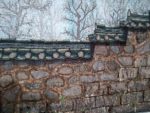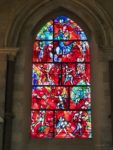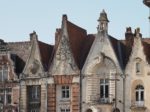To download a printable PDF version
click on this link E2E2019no4.pdf (three A4 pages)
and click here for Bethune photographs
Two days ago was a day of National Mourning in France, following the death of former president Chirac. But life outside Paris seemed unaffected. Unlike some previous days of mourning, everyone was at work. We had been warned that a routine hospital check-up in Strasbourg might well be cancelled, as on previous such occasions, but it was not. And by the time of the minute of silence at 3 o’clock, we were probably in busy IKEA, where nothing came to a respectful halt at any stage.
Far more significant in Entre-deux-Eaux was the funeral the previous Monday of our neighbour, Pierre Laine. The village church, which only has about three services a year now, was full with family and neighbours, and there were two military (veterans) flag bearers. His death was not a shock, as he had been ill for a couple of years following heart attacks, and he had dozed most of the morning Helen spent with Danielle a few days before his death. He was a man of few words, and his increasing deafness had cut him off further in recent years, so it was good to hear in the tributes a little of his earlier life, having to leave home with his family during the war and seek refuge on the Col du Plafond, and later doing his military service which included Algeria. And of course there was mention of his enjoyment of hunting. Our memories of him go back almost thirty years, as Danielle and Pierre welcomed us when we bought her aunt and uncle’s house, and they were always available to recommend reliable workmen and traders. And during the early years when we let out the house for holidays when we were not there, they would sort out any problems for our guests, and advise them on activities and practical details like fishing permits, sometimes without any language in common. One of our favourite stories about Pierre (which we’ve probably recounted before) was my mother enquiring whether he had killed any wild boar (sangliers), which M. Laine denied with surprising vehemence, having thought she asked about killing Englishmen (anglais)!
Helen was once given a very personal introduction to some of the former villagers when she walked with three of the Oldies Club up to the church cemetery and was taken round some of the graves. On Heritage Day this September she joined a far more academic visit to the imposing family chapels erected by wealthy nineteenth century industrialists in the second Saint Dié cemetery. This graveyard lies in the outskirts of Saint Dié, on a rise overlooking their factories, and with the industries long closed seems very peaceful. Later that afternoon there was an interesting talk at the library about its innovative post-war librarian, museum curator and historian Albert Ronsin, who took it from a gentlemen’s reading room to a modern public access building for everyone. It was a timely lecture as in a few days the library closes its doors and prepares for a move in 2021 to a spacious intercommunal mediatheque (a converted former police and high court building).
Over in Strasbourg this Monday, after the hospital appointment on the day of national mourning, we treated ourselves to lunch in another converted building, the former eighteenth century Les Haras riding academy and stud farm. We had looked at it both when it was all shuttered and when the conversion was nearing completion, but since then the courtyard has acquired a magnificent statue of a horse. It was a grand feeling to sweep up the circular central staircase and sit beneath the magnificently beamed roof. The starter of leeks and smoked trout was delicate and tasty, and the sweet chestnut dessert was interesting (and reminded us of gathering sweet chestnuts on the way to other restaurant meals), but the main course was less adventurous – basically pork and beans. Still, a great improvement on a restaurant which has re-opened in Saint Dié as Logan Laug and which we tried out with Roger and Dorinda during their September return trip. But what do we know about food? – We are only English, as the French would retort dismissively.
But lets not focus too long on food. There is also heating. The French climate change plan includes the proposal to phase out of oil heating boilers in ten years. There is no natural gas here in the village, even though the pipeline is only a kilometre away. Our oil boiler is twenty years old so this autumn John investigated replacing it with a heat pump. Unfortunately, even with government grants, based on current fuel and electricity costs, the payback period for the 16,000€ cost would have been over twenty years. And that is just for an air-water heat pump which would not provide enough warmth during our coldest (night-time down to -18°C) weeks. So we would have to keep the oil boiler or install an additional automatic heating system. A ground source heat pump or a wood pellet stove which could meet our requirements would have been even more expensive. In Paris-centric France, this is very much a rural problem, to add to lack of public transport, scarcity of public services, and slow broadband.
Meanwhile there have been all the familiar September activities, like the Patchwork festival in the small towns around Sainte-Marie-aux-Mines, the big street market or braderie in Saint Dié, and the various clubs and lectures have resumed. Outside the leaves are beginning to change to autumn shades, and we have emptied and folded up the small swimming pool, coiled up and stored the potager trickle-watering tubes, and brought the benches, outdoor seats and some delicate plants into a barn. After all, we could be into heavy frosts by the time we return to Entre-deux-Eaux at the end of October.
When we drove over to England in August, it felt as if the port of Calais had given up on security checks in exasperation. There were no armed soldiers/police doing vehicle checks and passport control was cursory. As ever, we enjoyed spending a bit more time with Jacob and catching up with friends. And this trip we had a bit more time for history and nostalgia. The newly re-opened museum in Hitchin set us looking for the sites of neolithic henges in fields close to our Letchworth house and we enjoyed the sense of history and continuity in trips to Ely, Cambridge, Hertford and Old Stevenage. We found a pleasant walk over the fields from Letchworth to Ickleford along the Icknield Way, taking in a lavender farm and one of the three pubs, the Old George. And for a more recent bit of history, we had an unusual evening with Julia and Graham who were enjoying dancing in the ballroom of the former Spirella Corset Factory in Letchworth.
On the way home, we visited Fishbourne and its early Roman mosaics, Chichester cathedral with its tapestries and Chagal window, and briefly stopped in picturesque Arundel to check a stone lion in front of the castle. Why the latter, you might ask? There is a black and white photo of a proud nine-year old sitting on a stone lion, which Helen has always thought was taken at Arundel; we decided against the £19.50 entrance fee just to see the lion (which a guard confirmed was indeed there, along with a horse) and instead bought two pairs of much needed replacement Moroccan slippers for John from a craft fair.
Back on the French side of the Channel after equally brief checks and a calm crossing in which and we could see the white cliffs of France beckoning from the start of the crossing, we stopped for the night near Bethune in a cheap Ibis on one of those out of town commercial centres. Adjacent was a cinema and some chain restaurants, so we had a late dinner in one of the “Crocodile” chain restaurants (named after a style of European train with a long “nose” at each end) where we have discovered that the set price cold buffet provides a varied meal (including free wine, beer, etc.) without need of a main course or desserts and, for a bit of atmosphere, there is a train compartment for some of the diners and an overhead model train.
In the morning we went into Bethune, finding a quiet parking spot under the church on the hill, right by the huge war memorial commemorating the town’s soldiers and civilians; the peace was shattered by the sounds of the cars in the main square revving up as they set out at spaced intervals on a stage of an annual car race. The outdoor cafe tables were full of fans and families watching and drinking in the sunshine, so, having wandered round as John took photos of many of the elaborately reconstructed buildings of the mid 1920s, we joined the coffee drinkers at one of those bars whose interior looked as if it hadn’t changed since the 1950s.
We just hope that journeys between the two countries are as straightforward after 31st October.




